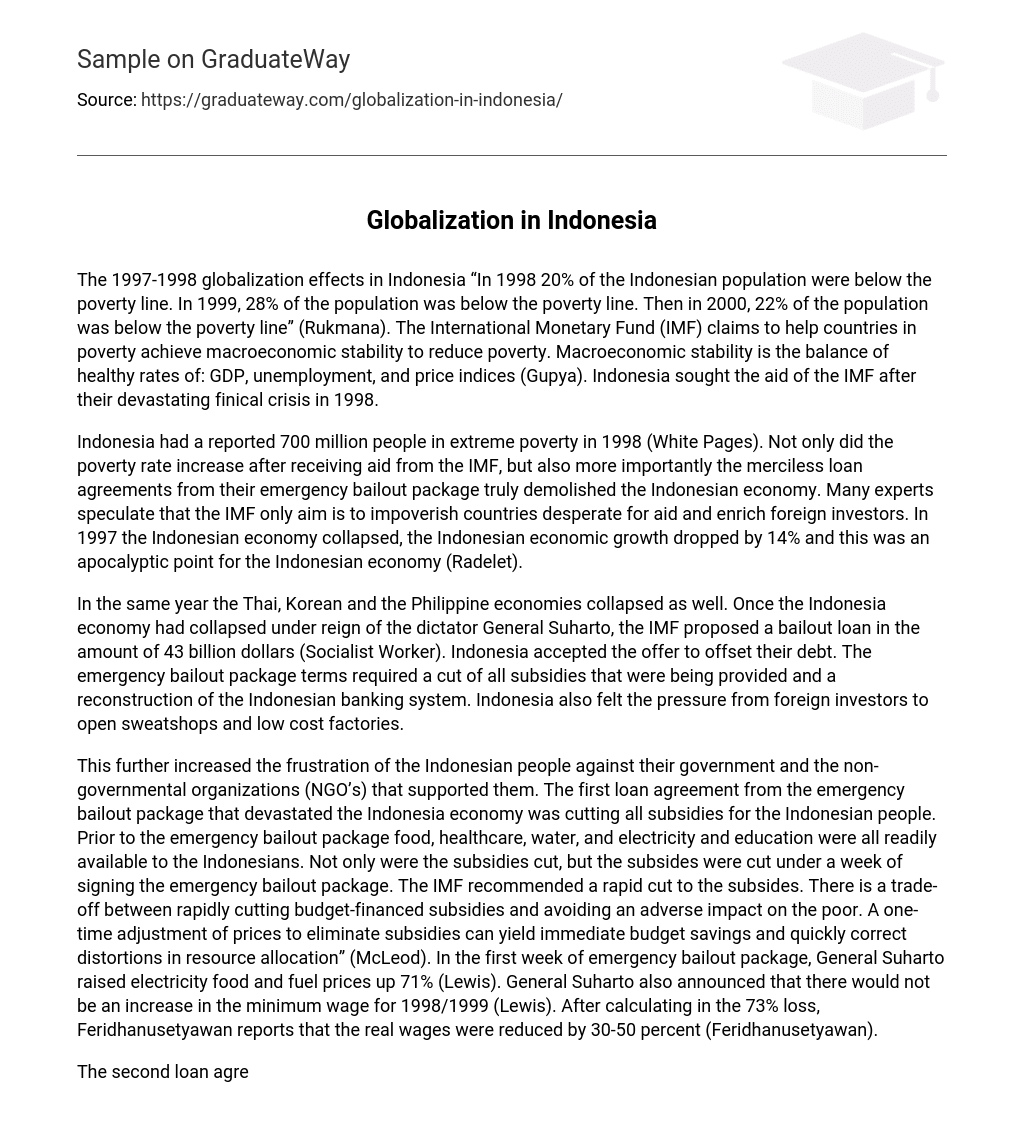The 1997-1998 globalization effects in Indonesia “In 1998 20% of the Indonesian population were below the poverty line. In 1999, 28% of the population was below the poverty line. Then in 2000, 22% of the population was below the poverty line” (Rukmana). The International Monetary Fund (IMF) claims to help countries in poverty achieve macroeconomic stability to reduce poverty. Macroeconomic stability is the balance of healthy rates of: GDP, unemployment, and price indices (Gupya). Indonesia sought the aid of the IMF after their devastating finical crisis in 1998.
Indonesia had a reported 700 million people in extreme poverty in 1998 (White Pages). Not only did the poverty rate increase after receiving aid from the IMF, but also more importantly the merciless loan agreements from their emergency bailout package truly demolished the Indonesian economy. Many experts speculate that the IMF only aim is to impoverish countries desperate for aid and enrich foreign investors. In 1997 the Indonesian economy collapsed, the Indonesian economic growth dropped by 14% and this was an apocalyptic point for the Indonesian economy (Radelet).
In the same year the Thai, Korean and the Philippine economies collapsed as well. Once the Indonesia economy had collapsed under reign of the dictator General Suharto, the IMF proposed a bailout loan in the amount of 43 billion dollars (Socialist Worker). Indonesia accepted the offer to offset their debt. The emergency bailout package terms required a cut of all subsidies that were being provided and a reconstruction of the Indonesian banking system. Indonesia also felt the pressure from foreign investors to open sweatshops and low cost factories.
This further increased the frustration of the Indonesian people against their government and the non-governmental organizations (NGO’s) that supported them. The first loan agreement from the emergency bailout package that devastated the Indonesia economy was cutting all subsidies for the Indonesian people. Prior to the emergency bailout package food, healthcare, water, and electricity and education were all readily available to the Indonesians. Not only were the subsidies cut, but the subsides were cut under a week of signing the emergency bailout package. The IMF recommended a rapid cut to the subsides. There is a trade-off between rapidly cutting budget-financed subsidies and avoiding an adverse impact on the poor. A one-time adjustment of prices to eliminate subsidies can yield immediate budget savings and quickly correct distortions in resource allocation” (McLeod). In the first week of emergency bailout package, General Suharto raised electricity food and fuel prices up 71% (Lewis). General Suharto also announced that there would not be an increase in the minimum wage for 1998/1999 (Lewis). After calculating in the 73% loss, Feridhanusetyawan reports that the real wages were reduced by 30-50 percent (Feridhanusetyawan).
The second loan agreement from the emergency bailout package that truly damaged Indonesia economy was for Indonesia to close banks that were not up to par with the IMF’S standard of liquidity. During the Indonesian crisis, the IMF required the closing of 84 small banks and 16 large banks (Feridhanusetyawan). The smaller banks significantly operated at a more lucrative rate the larger banks. But the IMF closed over 84 banks that they determined “Troubled”. (Markar-Macan) After the IMF and the Indonesian government closed the 16 large banks General Suharto opened only one of those closed banks.
That bank reopened with a new owner, General Suharto’s son (Radelet). “In view of all this, it is highly paradoxical that the restructuring plan devised by the IMF and the government reduced capital requirements, nationalized many banks, and forced mergers among several of the banks that survived” (McLeod). Finally, in 2008 Indonesia was in the identical predicament as it was in 1998, but this time over 10 years later; Indonesia refused the bailout offer from the IMF. Once Indonesia refused for over 3 months the bail out loan increased 5 times more then the original offer.
At that time Indonesia was the only country to get that high of a bid. The former finance minister Rizal Ramli stated ‘’with the IMF’s involvement 10 years ago the crisis plunged deeper than necessary. ” (Markar-Macan) Rizal Ramli also stated ’Indonesians do not want to taste the same bitter pill again. ’’(Markar-Macan) In conclusion, the damages and the set backs to the Indonesian economy have been monumental and scarring. The IMF’s intentions are disputable and available for speculation. But more importantly the Indonesian economy suffered more after the aid of the IMF.
Many Indonesians feel as if they were on the right track before they had any interference with IMF. Nether the less, Indonesia is still currently rebuilding from the damage that the IMF caused hopefully countries in need will take note to the “Bitter Pill” that Indonesia had swallowed and refuse assistance from organizations like the IMF. Works Cited Feridhanusetyawan, Tubagus. ” Preferential Trade Agreements in the Asia-Pacific Region” July 2005. Web. 7 Apr. 2012. Gupya, Sanjeev. ” Equity and Efficiency in the Reform of Price Subsidies”15 December 2001. Web. 7 Apr. 2012. Lewis, Vanessa. IMF demands price increase, mass protests follow” Web. 10 Apr. 2012. Markar-Macan, Marwaan. ” Saying No, Thank you to the IMF Loans” Web. 10 Apr. 2012. McLeod H. Ross. ” Indonesia’s Monetary Muddle”9 February 2009. Web. 7 Apr. 2012. Radelet, Steven. ” Indonesia: Long Road to Recovery” March 1999. Web. 8 Apr. 2012. Rukmana, Deden. ” Urban Poverty and Inequality in Jakarta” 8 April 2007. Web. 6 Apr. 2012. Socialist Worker. ” How the IMF gang wrecked Indonesia”1 4 September 2001”. Web. 10 Apr. 2012. White Pages. “The plan for the Future, 2008” Web. May 2006. Web. 5 April 5 2012.





